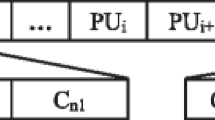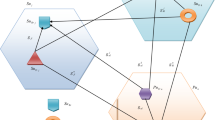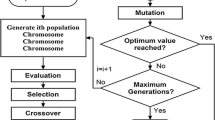Abstract
With the increasing demands for wireless communication, efficiently using the spectrum resource has always been an important research topic. In this paper, the problem of N pairs of Secondary Users (SU) sharing K available channels with M Primary Users and its associated problem of optimal channel allocation and power control are studied. To investigate a joint channel and power allocation for the underlay-based Cognitive Radio Networks, a sum-rate maximization problem of the SU with consideration of Quality of Service and the constraints of interference temperature and outage probability is formulated as a Mixed Integer Nonlinear Programming problem. To solve it, the objective function is divided into two sub-optimization problems: channel allocation and power control. First of all, we propose to use the Genetic Algorithm Channel Allocation algorithm (GACA) to solve the channel allocation optimization problem and get the optimal channel allocation strategy. The power control optimization is then followed, but the problem is a fractional form of function with coupling constraints that is non-convex and cannot be solved directly with convex optimization. To this end, when the SINR is sufficiently high, we obtain optimal power control strategy by introducing Geometric Programming and auxiliary variables to convert non-convex to Convex Geometric Programming. When SINR is the medium to low value, we use an iterative algorithm known as the Single Condensation Method to solve it. Finally, through our proposed iterative algorithm, that is, Joint Optimization Algorithm (JOA), the optimal solution is obtained. Moreover, the convergence and complexity of the algorithm are analyzed. The time complexity of JOA in the worst case is \(O(N^{3} \sqrt N )\). In order to show the generality of the channel state, in the simulation part, we design a perfect CSI optimal solution scenario and a imperfect CSI sub-optimal solution scenario. Simulation results show that the proposed algorithm can achieve better performance under different CSI states.













Similar content being viewed by others
References
Quach, T. X., Tran, H., Uhlemann, E., Kaddoum, G., & Tran, Q. A. (2017). Power allocation policy and performance analysis of secure and reliable communication in cognitive radio networks. Wireless Networks. https://doi.org/10.1007/s11276-017-1605-z.
Benaya, A. M., Rosas, A. A., & Shokair, M. (2017). Proposed scheme for maximization of minimal throughput in MIMO underlay cognitive radio networks. Wireless Personal Communications,96(4), 5947–5958.
Federal Communications Commission. (2003). Notice of proposed rule making and order. ET Docket no. 03-222.
Cheng, Q., & Kollimarla, B. (2009, March). Joint channel and power allocation based on user satisfaction for cognitive radio. In 43rd annual conference on information sciences and systems, 2009. CISS 2009. (pp. 579–584).
Liu, Y., Dong, L., & Marks, R. J. (2013, April). Common control channel assignment in cognitive radio networks using potential game theory. In Wireless communications and networking conference (WCNC), 2013 IEEE (pp. 315–320).
Park, P. (2015). Power controlled fair access protocol for wireless networked control systems. Wireless Networks,21(5), 1499–1516.
Zhao, G., Yang, C., Li, G. Y., Li, D., & Soong, A. C. (2011). Power and channel allocation for cooperative relay in cognitive radio networks. IEEE Journal of Selected Topics in Signal Processing,5(1), 151–159.
Lee, J., Wang, H., Andrews, J. G., & Hong, D. (2011). Outage probability of cognitive relay networks with interference constraints. IEEE Transactions on Wireless Communications,10(2), 390–395.
Li, F., Wang, L., Hua, J., Meng, L., & Zhang, J. (2015). Power optimization for dynamic spectrum access with convex optimization and intelligent algorithm. Wireless Networks,21(1), 161–172.
Hu, H., Zhang, H., & Yu, H. (2016). Energy-efficient sensing for delay-constrained cognitive radio systems via convex optimization. Journal of Optimization Theory and Applications,168(1), 310–331.
Lun, T., Lin, H., Huan, W., & Qian-bin, C. (2009, November). Power allocation based on Convex Optimization Theory for fading channels in OFDM-based cognitive radio networks. In International conference on wireless communications & signal processing, 2009. WCSP 2009. (pp. 1–5).
Zhou, F., Beaulieu, N. C., Li, Z., Si, J., & Qi, P. (2016). Energy-efficient optimal power allocation for fading cognitive radio channels: Ergodic capacity, outage capacity, and minimum-rate capacity. IEEE Transactions on Wireless Communications,15(4), 2741–2755.
Devraj, A. M., Sharma, M. K., & Murthy, C. R. (2014). Power allocation in energy harvesting sensors with ARQ: A convex optimization approach. In IEEE global conference on signal and information processing (GlobalSIP), 2014 (pp. 208–212).
Chen, W. H., Lin, W. R., Tsao, H. C., & Lin, C. (2016). Probabilistic power allocation for cognitive radio networks with outage constraints and one-bit side information. IEEE Transactions on Signal Processing,64(4), 867–881.
Seong, K., Mohseni, M., & Cioffi, J. M. (2006). Optimal resource allocation for OFDMA downlink systems. In IEEE international symposium on information theory, 2006 (pp. 1394–1398).
Xu, Y., & Zhao, X. (2015). Distributed power control for multiuser cognitive radio networks with quality of service and interference temperature constraints. Wireless Communications and Mobile Computing,15(14), 1773–1783.
Zhao, N. (2016). Joint optimization of cooperative spectrum sensing and resource allocation in multi-channel cognitive radio sensor networks. Circuits, Systems, and Signal Processing,35(7), 2563–2583.
Liu, X., Li, F., & Na, Z. (2017). Optimal resource allocation in simultaneous cooperative spectrum sensing and energy harvesting for multichannel cognitive radio. IEEE Access,5, 3801–3812.
Kolodzy, P., & Avoidance, I. (2002). Spectrum policy task force. Federal Communication Commission, Washington, DC, Report ET Docket,40(4), 147–158.
Xu, D., Feng, Z., Li, Y., & Zhang, P. (2011). Fair channel allocation and power control for uplink and downlink cognitive radio networks. In GLOBECOM Workshops (GC Wkshps), 2011 IEEE (pp. 591–596)
Hoang, A. T., & Liang, Y. C. (2006). Maximizing spectrum utilization of cognitive radio networks using channel allocation and power control. In IEEE 64th vehicular technology conference, 2006. VTC-2006 Fall (pp. 1–5).
El Nainay, M. Y., Friend, D. H., & MacKenzie, A. B. (2008, October). Channel allocation & power control for dynamic spectrum cognitive networks using a localized island genetic algorithm. In 3rd IEEE symposium on new frontiers in dynamic spectrum access networks, 2008. DySPAN 2008 (pp. 1–5).
Chiang, M., Tan, C. W., Palomar, D. P., O’neill, D., & Julian, D. (2007). Power control by geometric programming. IEEE Transactions on Wireless Communications,6(7), 2640–2651.
Singh, S., Teal, P. D., Dmochowski, P. A., & Coulson, A. J. (2012, June). Interference management in cognitive radio systems—A convex optimisation approach. In IEEE international conference on communications (ICC), 2012 (pp. 1884–1889).
Hamdi, M., Yuan, D., & Zaied, M. (2017). GA-based scheme for fair joint channel allocation and power control for underlaying D2D multicast communications. In 13th international IEEE wireless communications and mobile computing conference (IWCMC), 2017 (pp. 446–451).
Shi, G. Y. (1981). Algorithms for generalized geometric programming and their convergence. Journal of Dalian Institute of Technology,3, 19–25.
Kandukuri, S., & Boyd, S. (2002). Optimal power control in interference-limited fading wireless channels with outage-probability specifications. IEEE Transactions on Wireless Communications,1(1), 46–55.
Singh, S., Teal, P. D., Dmochowski, P. A., & Coulson, A. J. (2012, June). Interference management in cognitive radio systems—A convex optimisation approach. In IEEE international conference on communications (ICC), 2012 (pp. 1884–1889).
Liu, X., Jia, M., Gu, X. M., Yan, J. H., & Zhou, J. J. (2017). Optimal spectrum sensing and transmission power allocation in energy-efficiency multichannel cognitive radio with energy harvesting. International Journal of Communication Systems, 30(5), e3044.
Xing, Y., Mathur, C. N., Haleem, M. A., Chandramouli, R., & Subbalakshmi, K. P. (2006). Dynamic spectrum access with QoS and interference temperature constraints. IEEE Transactions on Mobile Computing,1(8), 1–11.
Yang, Y., Dai, L., Li, J., Mumtaz, S., & Rodriguez, J. (2017). Optimal spectrum access and power control of secondary users in cognitive radio networks. EURASIP Journal on Wireless Communications and Networking,2017(1), 98. https://doi.org/10.1186/s13638-017-0876-5.
Wei, Z., Ng, D. W. K., Yuan, J., & Wang, H. M. (2017). Optimal resource allocation for power-efficient MC-NOMA with imperfect channel state information. IEEE Transactions on Communications,65(9), 3944–3961.
Masmoudi, R., Belmega, E. V., & Fijalkow, I. (2017). Impact of imperfect CSI on resource allocation in cognitive radio channels. In International workshop on pervasive and context-aware middleware (PerCAM 17) IEEE WiMOB 2017.
Wong, I. C., & Evans, B. L. (2009). Optimal resource allocation in OFDMA systems with imperfect channel knowledge. IEEE Transactions on Communications, 57(1), 232–241.
Acknowledgments
This work is supported in part by National Natural Science Foundation of China (No. 61379005) and (No. 61771410), 2016 Key base of tourism and scientific research of Sichuan Provincial Tourism Administration (No. ZHZ16-02), and 2017, 2018 Artificial Intelligence Key Laboratory of Sichuan Province (No. 2017RYY05, No. 2018RYJ03), and 2017 Horizontal Project (No. HX2017134), and 2015 Teaching Reform Project (No. B11605035). This work is also supported by Postgraduate Innovation Fund Project by Southwest University of Science and Technology (No. 18ycx115).
Author information
Authors and Affiliations
Corresponding authors
Appendix A
Appendix A
1.1 Proof of CGP (32)
We let \(\tilde{T}_{l} = c_{l} e^{{o_{l}^{T} \tilde{p}}},\) denoted as ol = (o1l, o2l, …, onl)T. Meanwhile, let \(\nabla \tilde{T}_{l} = \tilde{T}_{l} o_{l},\) denoted as \(\tilde{f}(\tilde{p}) = \log \tilde{f}_{0} (\tilde{p}),\) then \(\nabla \tilde{f}(\tilde{p}) = {{\nabla \tilde{f}_{0} (\tilde{p})} \mathord{\left/ {\vphantom {{\nabla \tilde{f}_{0} (\tilde{p})} {\tilde{f}_{0} (\tilde{p})}}} \right. \kern-0pt} {\tilde{f}_{0} (\tilde{p})}},\)
where
Du to \(\tilde{T}_{l} > 0,\tilde{T}_{{l^{\prime}}} > 0,\) and \(\left( {o_{l} - o_{{l^{\prime}}} } \right)\left( {o_{l} - o_{{l^{\prime}}} } \right)^{T}\) is positive definite. Therefore, \(\log \tilde{f}_{0} (\tilde{p})\) is a convex function. Similarly, we can prove that \(\log \tilde{f}_{i} (\tilde{p}),\;i = 1,2, \ldots ,N\) is a convex function, so that Eq. (31) is a Convex Geometric Programming problem (CGP).
Rights and permissions
About this article
Cite this article
He, X., Jiang, H., Song, Y. et al. Joint optimization of channel allocation and power control for cognitive radio networks with multiple constraints. Wireless Netw 26, 101–120 (2020). https://doi.org/10.1007/s11276-018-1785-1
Published:
Issue Date:
DOI: https://doi.org/10.1007/s11276-018-1785-1




